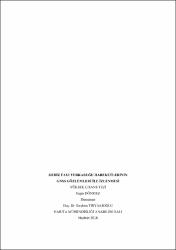| dc.contributor.advisor | Tiryakioğlu,İbrahim | |
| dc.contributor.author | Dönmez,Ergin | |
| dc.date.accessioned | 2019-05-16T06:50:54Z | |
| dc.date.available | 2019-05-16T06:50:54Z | |
| dc.date.issued | 2018 | |
| dc.identifier.uri | http://hdl.handle.net/11630/5846 | |
| dc.description | Observation and examination of crust deformations have a very important in exploring the potential of future earthquakes. Today, geodetic networking is a highly preferred method for monitoring superficial crustal deformations. Particularly, the use of GNSS in geodetic network measurements since the 1980s has made this method very useful. The measurement of networks established with GNSS can be done independently than time, cheaper, easier, and more reliable. The Gediz fault is a fault which has produced major earthquakes in history. The latest earthquake occurred on March 28, 1970, at around 23:00 local time in the Gediz region known as the west of central Kütahya. Western Anatolia shaken by this earthquake. After 1970 earthquake which known as the Great Gediz earthquake, any earthquakes have not occur on until today. The longest earthquake producing period of the fault is 48 years.
In this thesis study, Gediz fault which has not produced an earthquake for 48 years has been investigated by GNNS observations. A GNSS network with 22 points around the district of Gediz fault has been stablished. The network is regularly and periodically measured in 2016, 2017, and 2018. The velocity vectors and strain fields of the region are calculated. As a result of the strain analysis, the extensions has been observed that are generally in the direction of K-G in the region. It can be stated that the results of this study and the geological studies in the region are in harmony. | en_US |
| dc.description.abstract | Kabuk deformasyonlarının gözlenmesi ve incelenmesi gelecekte olabilecek depremlerin potansiyellerinin araştırılmasında hayati bir öneme sahiptir. Günümüzde jeodezik ağ kurma yöntemi yüzeysel kabuk deformasyonlarının izlenmesinde, oldukça tercih edilen bir yöntemdir. Özellikle 1980’li yıllardan itibaren jeodezik ağ ölçümünde GNSS (Küresel Navigasyon Uydu Sistemleri) kullanılması bu yöntemi oldukça kullanışlı hale getirmiştir. GNSS ile kurulan ağların ölçülmesi zamandan bağımsız olarak daha ucuza, daha kolay ve daha güvenilir olarak yapılabilmektedir. Gediz fayı tarihte büyük depremler üretmiş bir faydır. En son 28 Mart 1970 tarihinde, yerel saatle 23.00 civarında, merkezi Kütahya'nın batısındaki Gediz yöresinde bir deprem meydana gelmiştir. Depremde Batı Anadolu sarsılmıştır. 1970 Büyük Gediz depremi olarak bilinen depremden günümüze kadar fayda herhangi bir deprem meydana gelmemiştir. Fayın en uzun deprem üretme periyodu 48 yıldır.
Bu tez çalışmasında 48 yıldır deprem olmayan Gediz fayı GNNS gözlemleri yapılarak incelenmiştir. Çalışma bölgesi olan Gediz ilçesi çevresine 22 noktalı bir GNSS ağı kurularak 2016, 2017 ve 2018 yıllarında ağ düzenli ve periyodik olarak ölçülmüştür. Bölgeye ait hız vektörleri ve yamulma alanları hesaplanmıştır. Yamulma analizleri sonucunda bölgede genel olarak K-G yönlü açılmalar izlenmiştir. Bölgede yapılan jeolojik çalışmalar ile bulunan sonuçların uyum içinde olduğu görülmüştür. | en_US |
| dc.language.iso | tur | en_US |
| dc.rights | info:eu-repo/semantics/openAccess | en_US |
| dc.subject | Deprem, Küresel Navigasyon Uydu Sistemleri (GNSS), Gediz Fayı, GAMIT/GLOBK | en_US |
| dc.title | Gediz Fayı Yerkabuğu Hareketlerinin Gnss Gözlemleri ile İzlenmesi | en_US |
| dc.title.alternative | Monıtorıng of Tectonıcs Movements of Gedız Fault Wıth Gnss Observations | en_US |
| dc.type | masterThesis | en_US |
| dc.department | Afyon Kocatepe Üniversitesi, Fen Bilimleri Esntitüsü | en_US |
| dc.identifier.startpage | 1 | en_US |
| dc.identifier.endpage | 52 | en_US |
| dc.relation.publicationcategory | Tez | en_US |



















